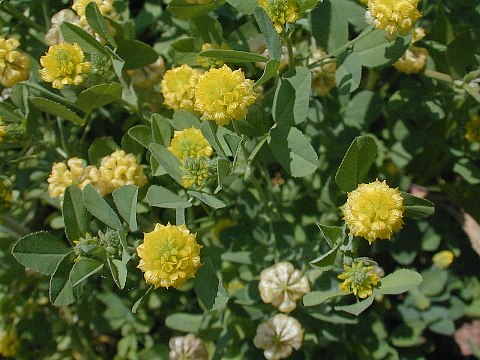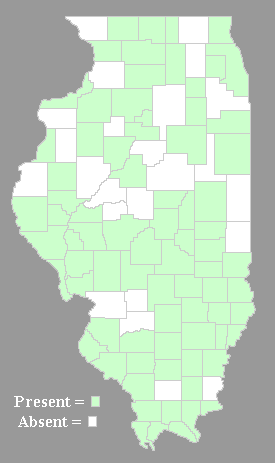Description: This annual plant is up to 1' tall, branching frequently and having a bushy appearance. The stems are green or reddish green and pubescent; they have a tendency to sprawl. The alternate leaves are trifoliate; they have long petioles that are hairless. The leaflets are ovate or obovate, hairless, and slightly dentate along the margins. They have conspicuous pinnate veins that are straight, but lack any white chevrons. The petiole of the middle leaflet is conspicuously longer than the petioles of the lateral leaflets; the petioles of the latter are often sessile, or nearly so. Each leaflet is about ¾" long and half as much across.

From the axils of the upper
trifoliate leaves, their develops individual flowerheads from pubescent
stalks about 1" in length. Each of these stalks is longer than the
petiole of the adjacent trifoliate leaf. The yellow flowerheads are up
to ½" across. They are more or less spherical and consist of about
15-40 flowers. Each flower is about 1/6" (4 mm.) long. It has 5
elongated
yellow petals and a light green calyx that is shorter than the petals
and inconspicuous. The upper petal, or standard, has an outer surface
that is conspicuously grooved; it is parallel to the keel (the lower
petals) and functions like a protective hood. The blooming period
occurs during the summer and lasts about 1-2 months. The petals of the
flowers are persistent, turning light brown or nearly white on the
flowerheads. Each flower produces a single seedpod that is shorter than
the persistent keel. The root system consists of a taproot, which can
form nodules on secondary roots to accommodate nitrogen-fixing
bacteria. This plant spreads by reseeding itself, and often forms
colonies.
Cultivation:
The preference is full or partial sun, moist to mesic conditions, and a
loam or clay-loam soil. It appears to favor fertile soil that is not
too dry.

Range & Habitat:
Low Hop Clover is a common plant that occurs in most counties of
Illinois, where it is not native. Habitats include savannas, abandoned
fields, pastures, edges
of paths, degraded meadows with a history of disturbance, and vacant
lots. This species is occasionally grown for forage or to rejuvenate
cropland. It prefers disturbed grassy areas, although it occasionally
invades natural areas to a limited extent. Low Hop Clover was
introduced into the United States from Eurasia.
Faunal Associations:
The flowers are pollinated primarily by various kinds of bees, which
seek nectar and pollen. Bee flies, small butterflies, and skippers may
visit the flowers as well. In general, the caterpillars of several Colias
spp. (Sulphur Butterflies) feed destructively on Trifolium spp.
(Clovers), as do many other insects, including leaf beetles, weevils,
larvae of leaf-miner flies, larvae of gall flies, broad-headed bugs,
plant bugs, stink bugs, aphids, leafhoppers, treehoppers, mealybugs,
Tiger moths, Geometer moths, Owlet moths, Tortrix moths, grasshoppers,
and thrips (see the Insect Table for a more complete list of these species). Insects that have been observed to feed specifically on Trifolium campestre (Low Hop Clover) include broad-headed bugs (Alydus eurinus, Alydus pilosulus), a stink bug (Hymenarcys nervosa), Acyrthosiphon pisum (Pea Aphid), and Therioaphis trifolii (Yellow
Clover Aphid); see Schaefer (1980), Rider website (2009), and Hottes
& Frison (1931). Among vertebrate animals, the Horned Lark,
Chipping Sparrow, and some other granivorous songbirds eat the seeds of
clovers, while such upland gamebirds as the Ruffed Grouse, Wild Turkey,
Hungarian Partridge, and Greater Prairie Chicken eat the foliage
primarily. Many mammals also feed on clovers, including the Prairie
Vole, Meadow Vole, Woodland Vole, Cottontail Rabbit, Groundhog,
Thirteen-lined Ground Squirrel, and American Black Bear (Martin et al.,
1951/1961; DeVore et al., 2004; Whitaker, 1972; Romain et al., 2013).
Photographic Location:
A weedy meadow at Judge Webber Park in Urbana, Illinois.
Comments:
This is the most common Hop Clover in Illinois. The flowers are bright
lemon yellow and reasonably attractive. The other Hop Clovers that
occur in Illinois, Trifolium aureum (Yellow Hop
Clover) and Trifolium dubium (Small Hop Clover),
are similar in appearance, except that the middle leaflets of their
trifoliate leaves have petioles that are no longer than the lateral
leaflets (they're often sessile, or nearly so). In Low Hop Clover, the
petioles of the middle leaflets are conspicuously longer than the
others. The common name of these species refers to the
persistent flowers, which bend downward with maturity and become light
brown or nearly white, causing the flowerheads to resemble the fruiting
heads of Humulus spp. (Hops). Another species, Medicago
lupulina (Black Medic), has similar flowers and foliage,
although its coiled black seedpods are quite different in appearance.
If the seedpods are unavailable for examination, it is still possible
to distinguish Low Hop Clover from Black Medic by comparing the
standards (upper petals) of their flowers. In Low Hop Clover, the
outside of the standard (facing upward) has conspicuous grooves along
its length, and it is held parallel to the length of the keel (the
lower petals). In Black Medic, the standard lacks conspicuous grooves
and it is held perpendicular to the length of the keel when the flower
is fully open.